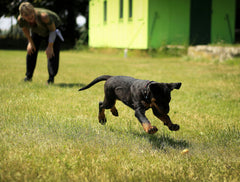
Retrievers are one of the most popular dogs to own, and for a good reason. You will typically find a retriever close to its owner, playing, doing tricks, or running after small animals.
Retrievers have a happy-go-lucky personality that is infectious. This breed is great around kids and is deemed as one of the go-to family dogs to own. A retriever’s nature is to obey, which makes them have a strong trainability. This helps those dog owners that are on the go and don’t want to leave their pup behind. There are six different retriever breeds, and we are going to take a look into each one!
History

Retrievers have been around since the mid-19th century. Their history reveals these magnificent dogs as hunters not on just land but also in water. Hunters used retrievers for their superb sense of smell to find the game they just killed and their ability to retrieve it without damage. That is how they got their name! Fishermen knew that these athletic dogs would come to good use around the fisheries. Retrievers are excellent swimmers, so they would retrieve the fishing nets and lines to shore. These pups have come a long way since their hunting days, and now they come in a variety of breeds to choose from!
Golden Retriever

One of the most well-known family-owned dogs is the beloved Golden Retriever. There is nothing more enticing than encountering a golden retriever personality. These mid-size furry dogs are friendly, loyal, and intelligent. Golden Retrievers have high energy, so going for a hike or playing a game of fetch with a Golden Retriever are great ways to allow them to release their pent-up energy constructively.
Typically Golden Retrievers are known for their golden, long-haired mane, but that is not always the case. Even though there is no such thing as a short-haired Golden Retriever, there are some out there that have shorter fur. This could be because they are a mix rather than a pure-bred Golden Retriever. Despite your preference in fur length, a Golden Retriever is an excellent option for a pup!
Labrador Retriever

You can find the Labrador Retriever in three different colors, yellow, brown, or black. A Labrador Retriever is a faithful companion and just wants to be around its family to be loved. They are also great with other animals, so if there are other animals in the house, a Labrador Retriever can be a great option to welcome your family of pets. The Lab is known for its athletic abilities and love of water. Having an active lifestyle for these pups is essential, and a place for them to go swimming is even better! A Labrador Retriever loves nothing more than running around, playing, and taking a lap or two in water.
Curly-Coated Retriever

There is no missing the sight of this pup when they stroll by. A Curly-Coated Retriever’s tight curly coat is something to marvel at. It is recommended to avoid brushing their coat altogether to prevent frizziness instead of only regularly bathing them. Curly-Coated Retrievers are known for more than just their glorious hairstyle. This breed is quite intelligent, excellent with children, and will gladly be put to work if you decide to do so. This versatile pooch will not only get the job done but will also look great doing it!
Flat-Coated Retriever

The sleek-maned pup known as the Flat-Coated Retriever is a muscular breed that is a leaner version of the Labrador Retriever but found to be one of the happiest breeds that exist. This fact makes them an excellent choice for a family with children, and you’ll find it hard not to fall in love with their sunny temperament. Their long mane does require weekly grooming to keep their shiny coat clean and healthy. Flat-Coated Retrievers are eager to please, which helps for training purposes, so if you don’t mind regular grooming, then a Flat-Coated Retriever might be for you!
Chesapeake Bay Retriever

Chesapeake Bay Retrievers are found to have somewhat of a wavy coat and are commonly are brown to red. These dogs have a muscular build which is ideal for a hunting dog. They can be trained, but they also have a reputation for going off on their path, so starting their obedience training as a young pup is a must!. Don’t let their muscular build fool you; Chesapeake Bay Retrievers are sensitive and don’t fair well with harsh scolding, so keep that in mind when training.
Nova Scotia Duck Tolling Retriever

Last but not least is the littlest Retriever among them all, the Nova Scotia Duck Tolling Retriever. Before welcoming this pup to your family, you want to make sure that you are up for the challenge. This Retriever is tireless and will have you exhausted from the endless games of fetch! This dog needs to have an array of athletic activities to get its energy out, so it isn’t ideal if you are never home or have a laid-back lifestyle.
Conclusion
Retrievers come in all shapes, sizes, and colors, but they all have come of the same qualities about them. They are all loveable and loyal dogs that are just looking for a family to love. There is no question why the retriever is one of the most popular dogs to own as a family. They are excellent around children, active, playful, and can get along with other animals as well. The best part about them is that they aren’t all about play, if you train them properly, they will go to work! As long as you are not afraid of regular grooming, these versatile loveable dogs would be an excellent addition to your home!
How big do golden retrievers get?
Do golden retrievers shed a lot?
How tall is a golden retriever?
Related Posts:
- Working Dog Breeds: Best Dogs for These Different Roles
- Australian Retriever: 5 Reasons This Dog Breed is the Best
- Best Companion Dogs for Families




